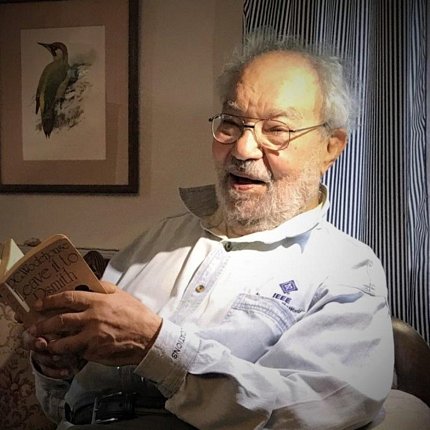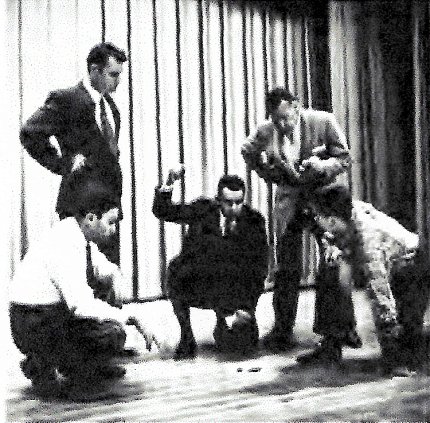Longtime Engineering Authority Eden Mourned

Photo: Abby Eden
Dr. Murray Eden, a renowned pioneer in the field of biomedical engineering and imaging and former director of the trans-NIH Biomedical Engineering and Physical Science Program for 18 years, died peacefully in his sleep on Aug. 9. He would have been 100 years old on Aug. 17.
Eden was professor emeritus in electrical engineering at MIT and worked at the intersection of mathematics, engineering, biology and medicine during the infancy of biomedical engineering.
In 1970, he co-authored the book Engineering and Living Systems with physician Dr. David D. Rutstein in which they described their new, interdisciplinary vision for health care in the future. Eden is also credited with foundational work in pattern recognition and its application in image processing for medical diagnoses.
Over his long career at MIT and NIH, he collaborated with colleagues from many disciplines and mentored young researchers and students who have gone on to distinguished careers. NIH recruited him from MIT in 1976 to oversee the Bioengineering and Physical Science Branch (then part of the former Division of Research Services, OD), and he dramatically expanded and enhanced the program. The program had a somewhat nomadic existence, moving over the years from DRS to NCRR to ORS and ultimately became the principal initial component of NIBIB’s intramural research program. Eden retired from NIH in 1994.
Under Eden’s inspirational leadership, members of the program collaboratively created numerous bioengineering firsts, ranging in scale from near-atomic resolution to applications for the clinic. These included: the first applications of wavelets to computed tomography; analytical methods (such as using electron microscopy for quantitative imaging of distributions of atomic elements in tissues); mechanical and electrical engineering designs enabling laser capture microdissection; serial block-face scanning electron microscopy; groundbreaking work in pharmacokinetics, including “convection-enhanced” delivery of drugs to brain tumors; analysis of macromolecular interactions by analytical ultracentrifugation; advances in the theoretical underpinnings and implementation of MRI, including critical radiofrequency circuits and “shielded gradients” enabling echo planar imaging; and creation of diffusion tensor imaging.
After earning a B.S. degree in chemistry from the City College of New York in 1941, Eden attended graduate school at the University of Maryland while supporting himself by working the night shift as a junior clerk-typist with the Civil Service Commission (thus began a term of government service spanning more than 50 years). Upon receiving his M.S. in physical chemistry from the University of Maryland, he began work as a biophysicist at the National Bureau of Standards in 1943. During World War II, he worked in the Princeton facility of the Manhattan Project alongside then student Dick Feynman and others, helping produce uranium-235.
He returned to the government as a physicist at the National Bureau of Standards. Six years later, he transferred to NCI as a biophysicist and completed his doctorate in physical chemistry and physics at the University of Maryland. From 1953 to 1955, he returned to Princeton to do postdoctoral work as a Public Health Service fellow and then returned to NIH within the Laboratory of Technical Development, NHLBI. In 1959, he took a job at MIT, where he co-founded the cognitive information processing group and headed it until 1976.
Eden found time over the years to serve as a lecturer, visiting professor or adjunct professor at institutions such as Harvard Medical School, American University, Boston University Law School, Johns Hopkins University, the Swiss Federal Polytechnic Institute at Lausanne and the University of Pennsylvania.
He also had numerous consultancies, including to the director-general of the World Health Organization in Geneva, Switzerland (1963 to 1992), and in 1983 he received the WHO Medical Society medal. He was also one of the principal technical consultants for the symbol standard subcommittee of the Uniform Grocery Product Code Council (1971 to 1974).

“That was the group that established the bar codes you see on all of the products you buy at the supermarket,” Eden said. “It was my idea to put the numbers underneath the code [as a failsafe], and I also picked the typeface for the numbers.” With a grin he added, “That’s my 15 minutes [of fame], and nobody knows about it.”
Eden loved music and often had resounding classical selections on his radio as he worked. In the 1950s, he played the role of Benny Southstreet in the NIH Hamsters (an employee theater group) production of Guys and Dolls.
“One of the many remarkable things about Murray was that he had so many careers,” said Dr. Hank Eden (no relation), who was deputy director of the Biomedical Engineering and Physical Science Program. “He seemed to have known everyone. In fact, framed on Murray’s wall was a piece of paper with equations scribbled on it from Albert Einstein’s wastebasket. [Murray retrieved it when he was a postdoc at Princeton.] Another aspect of Murray’s personality was that, despite all the things he accomplished and the famous people he knew, he was really down to earth. He also had a great sense of humor.”
Eden’s personal research focus was pattern recognition and quantification of biomedical images and their efficient storage. “Basically, I’ve been working on trying to model physiological processes,” he once said. “I’m interested in how to make machines do what humans can do because, by studying how to mimic human performance, we will better understand how the human machine operates.”
He leaves a brother, Dr. Alvin Eden of New York City; 5 children, Abigail Eden of Cherryfield, ME; Susanna Eden of Tucson, AZ; Mark D. Eden of Taos, NM; Shirley H. McDaniel, Venice, FL; and John W. Hartle, Juneau, AK; and 7 grandchildren.
